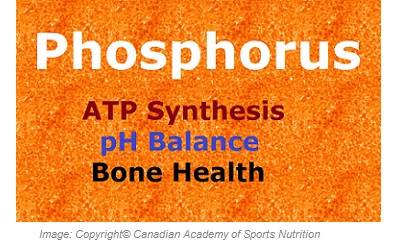Phosphorus is an essential mineral in the body. It is required for developing  bones and teeth, maintaining pH balance of the blood, synthesizing proteins, metabolizing carbohydrates and fats, and generating energy in the form of ATP.
bones and teeth, maintaining pH balance of the blood, synthesizing proteins, metabolizing carbohydrates and fats, and generating energy in the form of ATP.
Being a component of the fatty sheath of the nerves, the myelin, phosphorus is a part of the membranes of all cells. It is also a part of 2,3-diphosphoglycerate (2,3-DPG), which is present in the red blood cells.
Food Sources and Absorption of Phosphorus:
Phosphorus is present in foods high in protein, such as fish, red meats, chicken, turkey, eggs, dairy products, pumpkin seeds, and Brazilian nuts. Fruits and vegetables are poor in phosphorus.
Phosphorus is about 1% of total body weight and a person has an average 600 – 700 grams of phosphorus in the body with the highest concentrations (about 85%) in the bones and teeth. Dietary phosphorus is absorbed efficiently (65%) by the small intestine even in the absence of vitamin D.
Phosphorus deficiency may manifest as osteomalacia (softening of the bones), muscle weakness, rhabdomyolysis, seizure, confusion, decreased pH level (acidosis), and ataxia (difficulty walking properly).
The normal blood level of phosphorus is 2.5 – 4.5 mg/dl (0.75 – 1.45 mmol/L), and its absorption is affected by many factors.
Factors that increase the absorption of phosphorus:
- Vitamin D.
- Vitamin A.
- PTH (parathyroid hormone).
- High protein diet.
- High consumption of phosphorus, such as having many soft drinks. They may contain up to 500 mg of phosphorus per container.
Factors that decrease the absorption of phosphorus:
- Large doses of calcium. Phosphorus and calcium can compete for absorption, and high doses of calcium lower the absorption of phosphorus. For better absorption, the ideal ratio of calcium to phosphorus is 1:1 or 1.5:1.
- Calcium – containing antacids.
- Aluminum – containing antacids.
- Iron.
- Magnesium.
- Alcohol.
Athletic Benefits of Phosphorus:
- It provides the phosphate in ATP to produce energy.
- Helps synthesize protein and muscle growth.
- May aid muscle contraction and repair muscle damage.
- May delay fatigue and exhaustion by supporting the conversion of vitamins B2 and B3 into their active forms and by elevating pH level (alkalizing the blood).
Non – Athletic Benefits of Phosphorus:
The following conditions may benefit from phosphorus:
- Osteoporosis.
- Chronic fatigue syndrome.
- Alzheimer’s disease.
- Multiple sclerosis.
- Epilepsy.
- Hypercalcemia (high blood levels of calcium).
Dosage:
Phosphorus is added to many multivitamins – multiminerals. The RDA for phosphorus for adults is 800 mg. The PDI (performance daily intake) of phosphorus for athletes and physically active adults is 800 – 1600 mg.
Interactions:
The potential interactions of phosphorus are as follows:
- Aluminium/Calcium – containing Antacids: they decrease the absorption of phosphorus.
- Anticonvulsants (phenobarbital and carbamazepine): they may lower blood levels of phosphorus.
- Corticosteroids: they may lower blood levels of phosphorus.
- Insulin: it may lower blood levels of phosphorus.
- Potassium – sparing diuretics (spironolactone and triamterene): concomitant consumption of phosphorus and these medications may raise blood levels of potassium to very dangerous levels.
- Birth control pills: they may lower blood levels of phosphorus.
- Heparin: it may increase blood levels of phosphorus.
- Catecholamines (epinephrine, dopamine, and albuterol): they may lower blood levels of phosphorus by shifting it to inside of the cells.
- Angiotensin converting enzyme (ACE) inhibitors (captopril, enalapril, lisinopril, and ramipril): they may lower blood levels of phosphorus.
- Etdironate: it may increase blood levels of phosphorus.

